您好,登錄后才能下訂單哦!
您好,登錄后才能下訂單哦!
這篇文章主要介紹“TypeScript中的技巧有哪些”,在日常操作中,相信很多人在TypeScript中的技巧有哪些問題上存在疑惑,小編查閱了各式資料,整理出簡單好用的操作方法,希望對大家解答”TypeScript中的技巧有哪些”的疑惑有所幫助!接下來,請跟著小編一起來學習吧!
通過 /** */ 形式的注釋可以給 TS 類型做標記提示,編輯器會有更好的提示:
/** This is a cool guy. */ interface Person { /** This is name. */ name: string, } const p: Person = { name: 'cool' }如果想給某個屬性添加注釋說明或者友好提示,這種是很好的方式了。
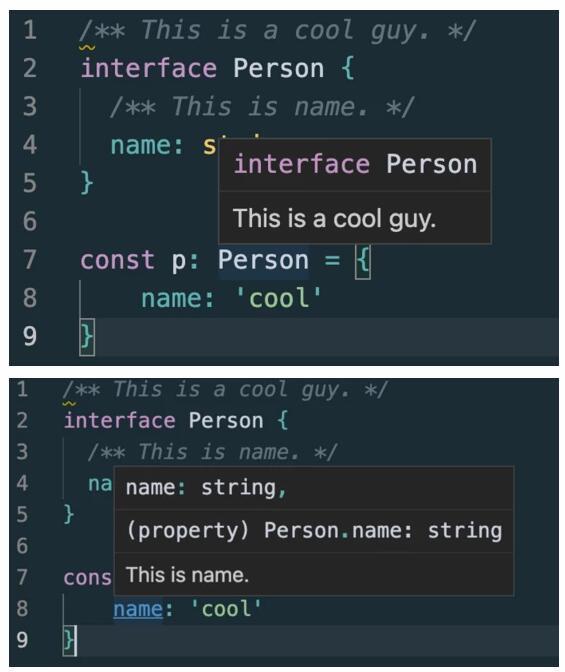
和類一樣,接口也可以相互繼承。
這讓我們能夠從一個接口里復制成員到另一個接口里,可以更靈活地將接口分割到可重用的模塊里。
interface Shape { color: string; } interface Square extends Shape { sideLength: number; } let square = <Square>{}; square.color = "blue"; square.sideLength = 10;一個接口可以繼承多個接口,創建出多個接口的合成接口。
interface Shape { color: string; } interface PenStroke { penWidth: number; } interface Square extends Shape, PenStroke { sideLength: number; } let square = <Square>{}; square.color = "blue"; square.sideLength = 10; square.penWidth = 5.0;TypeScript 中定義類型的兩種方式:接口(interface)和 類型別名(type alias)。
比如下面的 Interface 和 Type alias 的例子中,除了語法,意思是一樣的:
interface Point { x: number; y: number; } interface SetPoint { (x: number, y: number): void; }type Point = { x: number; y: number; }; type SetPoint = (x: number, y: number) => void;而且兩者都可以擴展,但是語法有所不同。此外,請注意,接口和類型別名不是互斥的。接口可以擴展類型別名,反之亦然。
interface PartialPointX { x: number; } interface Point extends PartialPointX { y: number; }type PartialPointX = { x: number; }; type Point = PartialPointX & { y: number; };type PartialPointX = { x: number; }; interface Point extends PartialPointX { y: number; }interface PartialPointX { x: number; } type Point = PartialPointX & { y: number; };它們的差別可以看下面這圖或者看 TypeScript: Interfaces vs Types 。

所以檙想巧用 interface & type 還是不簡單的。
如果不知道用什么,記住:能用 interface 實現,就用 interface , 如果不能就用 type 。
typeof 操作符可以用來獲取一個變量或對象的類型。
我們一般先定義類型,再使用:
interface Opt { timeout: number } const defaultOption: Opt = { timeout: 500 }有時候可以反過來:
const defaultOption = { timeout: 500 } type Opt = typeof defaultOption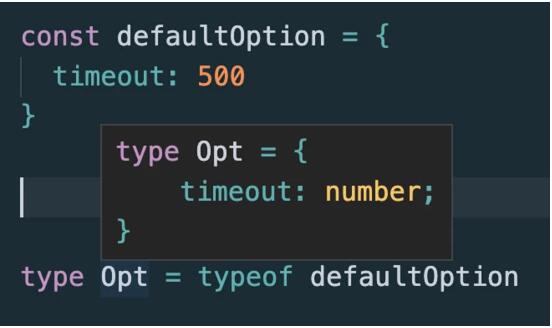
當一個 interface 總有一個字面量初始值時,可以考慮這種寫法以減少重復代碼,至少減少了兩行代碼是吧,哈哈~
TypeScript 允許我們遍歷某種類型的屬性,并通過 keyof 操作符提取其屬性的名稱。
keyof 操作符是在 TypeScript 2.1 版本引入的,該操作符可以用于獲取某種類型的所有鍵,其返回類型是聯合類型。
keyof 與 Object.keys 略有相似,只不過 keyof 取 interface 的鍵。
const persion = { age: 3, text: 'hello world' } // type keys = "age" | "text" type keys = keyof Point;寫一個方法獲取對象里面的屬性值時,一般人可能會這么寫
function get1(o: object, name: string) { return o[name]; } const age1 = get1(persion, 'age'); const text1 = get1(persion, 'text');但是會提示報錯

因為 object 里面沒有事先聲明的 key。
當然如果把 o: object 修改為 o: any 就不會報錯了,但是獲取到的值就沒有類型了,也變成 any 了。
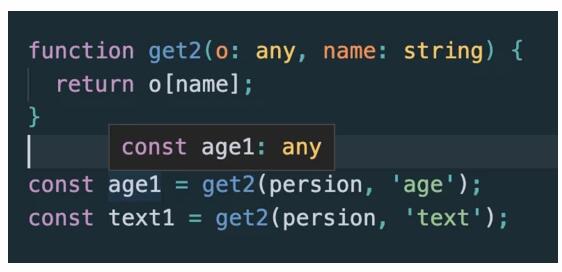
這時可以使用 keyof 來加強 get 函數的類型功能,有興趣的同學可以看看 _.get 的 type 標記以及實現
function get<T extends object, K extends keyof T>(o: T, name: K): T[K] { return o[name] }
interface Person { addr: { city: string, street: string, num: number, } }當需要使用 addr 的類型時,除了把類型提出來
interface Address { city: string, street: string, num: number, } interface Person { addr: Address, }還可以
Person["addr"] // This is Address.
比如:
const addr: Person["addr"] = { city: 'string', street: 'string', num: 2 }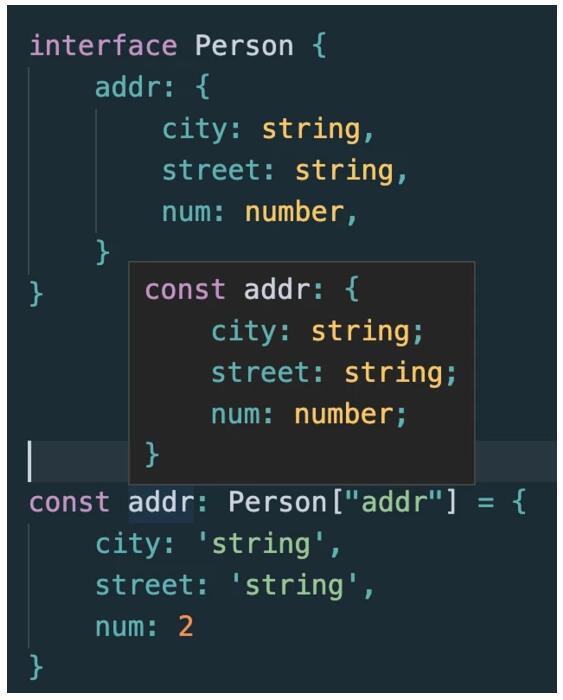
有些場合后者會讓代碼更整潔、易讀。
泛型(Generics)是指在定義函數、接口或類的時候,不預先指定具體的類型,而在使用的時候再指定類型的一種特性。
interface API { '/user': { name: string }, '/menu': { foods: string[] } } const get = <URL extends keyof API>(url: URL): Promise<API[URL]> => { return fetch(url).then(res => res.json()); } get(''); get('/menu').then(user => user.foods);
Vue 組件里面經常會用到 ref 來獲取子組件的屬性或者方法,但是往往都推斷不出來有啥屬性與方法,還會報錯。
子組件:
<script lang="ts"> import { Options, Vue } from "vue-class-component"; @Options({ props: { msg: String, }, }) export default class HelloWorld extends Vue { msg!: string; } </script>父組件:
<template> <div class="home"> <HelloWorld ref="helloRef" msg="Welcome to Your Vue.js + TypeScript App" /> </div> </template> <script lang="ts"> import { Options, Vue } from "vue-class-component"; import HelloWorld from "@/components/HelloWorld.vue"; // @ is an alias to /src @Options({ components: { HelloWorld, }, }) export default class Home extends Vue { print() { const helloRef = this.$refs.helloRef; console.log("helloRef.msg: ", helloRef.msg); } mounted() { this.print(); } } </script>因為 this.$refs.helloRef 是未知的類型,會報錯誤提示:

做個類型斷言即可:
print() { // const helloRef = this.$refs.helloRef; const helloRef = this.$refs.helloRef as any; console.log("helloRef.msg: ", helloRef.msg); // helloRef.msg: Welcome to Your Vue.js + TypeScript App }但是類型斷言為 any 時是不好的,如果知道具體的類型,寫具體的類型才好,不然引入 TypeScript 冒似沒什么意義了。
$('button') 是個 DOM 元素選擇器,可是返回值的類型是運行時才能確定的,除了返回 any ,還可以
function $<T extends HTMLElement>(id: string): T { return (document.getElementById(id)) as T; } // 不確定 input 的類型 // const input = $('input'); // Tell me what element it is. const input = $<HTMLInputElement>('input'); console.log('input.value: ', input.value);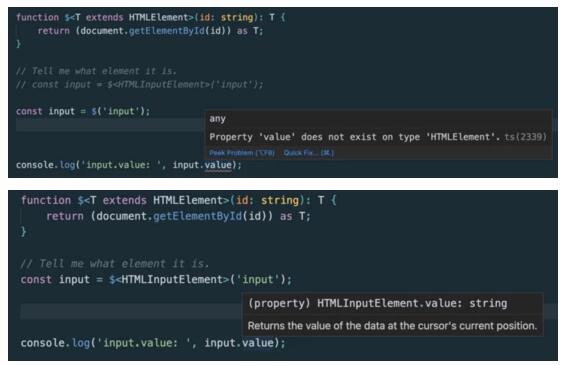
函數泛型不一定非得自動推導出類型,有時候顯式指定類型就好。
被 readonly 標記的屬性只能在聲明時或類的構造函數中賦值。
之后將不可改(即只讀屬性),否則會拋出 TS2540 錯誤。
與 ES6 中的 const 很相似,但 readonly 只能用在類(TS 里也可以是接口)中的屬性上,相當于一個只有 getter 沒有 setter 的屬性的語法糖。
下面實現一個深度聲明 readonly 的類型:
type DeepReadonly<T> = {
readonly [P in keyof T]: DeepReadonly<T[P]>;
}
const a = { foo: { bar: 22 } }
const b = a as DeepReadonly<typeof a>
b.foo.bar = 33 // Cannot assign to 'bar' because it is a read-only property.ts(2540)
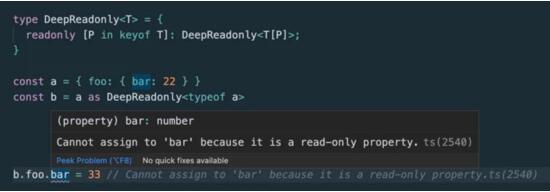
到此,關于“TypeScript中的技巧有哪些”的學習就結束了,希望能夠解決大家的疑惑。理論與實踐的搭配能更好的幫助大家學習,快去試試吧!若想繼續學習更多相關知識,請繼續關注億速云網站,小編會繼續努力為大家帶來更多實用的文章!
免責聲明:本站發布的內容(圖片、視頻和文字)以原創、轉載和分享為主,文章觀點不代表本網站立場,如果涉及侵權請聯系站長郵箱:is@yisu.com進行舉報,并提供相關證據,一經查實,將立刻刪除涉嫌侵權內容。